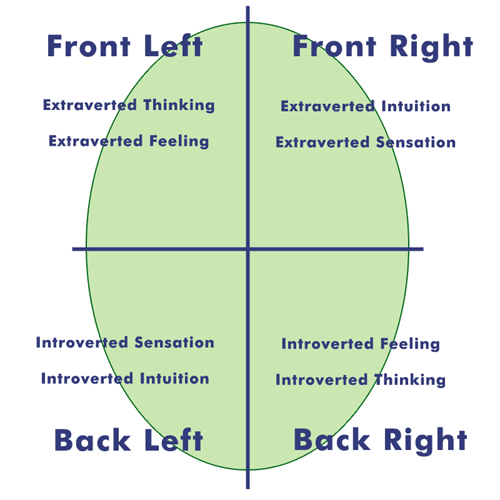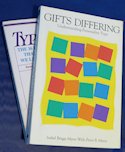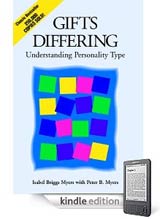
- About the MBTI
- Verify Your MBTI Type
- Personality Patterns
- MBTI Articles & Resources
- Article Directory for Educators & Students
- Books on Personality Types
- Emotional Intelligence & Personality Type
- Career Planning & MBTI
- MBTI Business Applications
- Lenore Thomson - Carl Jung Personality Type
- Site Map - Master Directory of All Articles
- MBTI Consultant Links
- Personality Type Workshops & Conferences
- Links to Other Type Websites
- Murder Mystery Business Theatre
- About Us
Volume 1, No. 1
Page 1. Intro to Jung's Psychological Type
Page 2. Brain types
Page 3. Functions - skills
Personality Type and Brain Physiology
Lenore Thomson Bentz . . . on Personality Type - Volume 1, No. 2.
Have a question about Personality Type or Carl Jung's Theory of Psychological Type? Send them to Lenore at lthombentz@aol.com. She will respond in this ongoing "Dear Lenore" column.
![]()
![]() Page Two, Volume 1, No. 1
Page Two, Volume 1, No. 1
JM: Your writing about young adult type preference changing as a result of relating to a significant other helped me understand the tension in my marriage at age 19. I felt forced to function as a Thinker to balance my husband's dominant Feeling preference. Although I identify as a lifelong INFP, my MBTI ® score on the Thinking-Feeling dichotomy has never been clear, hovering at the midpoint. Maybe others with similar experience will send questions that you can deal with in a future column, especially regarding what is innate.
LTB: This is what I mean by type reflecting an accustomed adaptive orientation, even when it's not entirely compatible with a self-image or a genuine issue of temperament. To ascribe this to type falsification implies that one has an innately determined type, but I believe that type results at odds with habituated strategies can give one a very good idea of what a person is doing, right now, to adapt to a particular environment. That kind of adaptation isn't necessarily false; it may reflect choices made for the sake of an authentic ideal or principle, whose price has become too high.
As far as I'm concerned, the only aspect of type likely to reflect a person's innate disposition is what Jung referred to as the attitudes, Extraversion and Introversion. Our dominant standpoint will always reflect the attitude that comes naturally to us. However, Jung contended that the vast majority of people have only a slight preference for either, and, for these types, cultural influence plays a greater role.
I also believe that we're likely to innately prefer a left- or right-brain approach to information, which implicates the J and P attitudes in the MBTI system.
Because of the attitudes, each function has two different ways of expression, resulting in eight function-attitudes -- Introverted and Extraverted versions of Sensation, Intuition, Feeling, and Thinking. As implied, my view is that Introverted and Extraverted versions of the same function come at information from opposing brain hemispheres.
When dominant and auxiliary functions implicate the right hemisphere, the type is usually outwardly adaptable to novelty and change, but this is balanced by a reliance on principles and values that are understood to be universal. In the MBTI system, these are the P types, whose preferred Extraverted function is either Sensation or Intuition.
When dominant and auxiliary functions implicate the left hemisphere, the type is usually invested in a collective outward charter that serves as a uniting lingua franca, but this is balanced by an inner world of impressions and alternatives that are understood to be individual. In the MBTI system, these are the J types, whose preferred Extraverted function is either Thinking or Feeling.

~ ~ ~ ~ ~
JM: Doesn't this brain map suggest that type preference depends on the inborn structure of the nervous system?
LTB: The only purpose of the brain map is to show how type preference relates to what the brain actually does. It doesn't mean that preference is a predetermined neurological structure, and it doesn't mean that you can drill into the cranium and locate the functions, cradled happily in their separate quadrants. What I'm trying to indicate is that tasks associated with the various functions implicate different parts of the brain.
For example, if the left frontal lobe of the brain is anesthetized, discrimination and executive judgment are rendered impossible. The frontal cortex is crucial to the tasks we associate with Extraverted Thinking and Extraverted Feeling.
If the right back hemisphere is anesthetized instead, executive judgment remains possible, but it occurs without reference to real subjective experience, spatial awareness, and contextual evaluation -- aspects associated with Introverted Thinking and Introverted Feeling. Without this input, the left brain simply fabricates whatever appears to "explain" how consequence is related to cause.
~ ~ ~ ~ ~
JM: One of the advantages of the brain map is that it helps to explain why the Extraverted and Introverted orientation of each function differ so dramatically. You characterize this difference as left brain constraint vs. right brain immediacy.
LTB: It seems to me that Jung was grappling with the distinction between Extraverted and Introverted functional orientation at a time when the brain hemispheres weren't so well understood. We know now that the left brain is largely responsible for maintaining a consistent world view, and the right brain is responsible for recognizing novelty. The brain map shows that each function is capable of doing either.
For example, Extraverted Sensation, which implicates the right brain, is concerned with direct experience, whereas Introverted Sensation, which implicates the left, is concerned with maintaining categories for experience.
Extraverted Thinking, which implicates the left brain, is concerned with reliable principles of behavior, which maintain order, whereas Introverted Thinking, which implicates the right brain, is concerned with consistent underlying processes, which allow one to predict change and flux.
The two hemispheres of the brain are designed to share their products across the corpus callosum; however, research indicates that cross-hemispheric communication can't take place diagonally. This would suggest that cognitive products associated with these diagonally related quadrants can't be simultaneously conscious.
Notice, for example, that Extraverted Thinking implicates the left front hemisphere, whereas Introverted Feeling implicates the right back hemisphere. Te and Fi are considered direct opposites for good neurological reason. In my view, this is why our least developed function is most likely to become conscious as we encounter its operation in others.
This is why I think it's a mistake to understand the functions as references to particular behavioral skills. They don't refer to abilities or actions; they refer to the structure of cognitive experience -- the way in which we reduce a constant bombardment of information to manageable forms that relate to our goals, beliefs, and preferences.
![]() Next Page -Jung Functions of Personality Type
Next Page -Jung Functions of Personality Type
Lenore Thomson is author of "Personality Type: An Owner’s Manual" and the former editor of the Jungian Journal Quadrant and a lecturer with the C.G. Jung Foundation in New York City. |
® MBTI, Myers-Briggs, Meyers Briggs, and Myers-Briggs Type Indicator are registered trademarks or trademarks of the Myers-Briggs Type Indicator Trust in the United States and other countries (aka meyers briggs or myers briggs).
![]()
Go Here to Learn more about Type Dynamics: The Dynamics of Type: Interpreting the MBTI ®Personality Type Code.
Go Here to Learn more about The Myers-Briggs Test *
*While commonly called a "test" the MBTI ® is not a test but a personality inventory in which there are no right or wrong answers.

"Personality Type: An Owner's Manual" by Lenore Thomson
A layman's guide to understanding Personality Type and the theory of Psychological Types originally proposed by C. G. Jung. Lenore Thomson was the former editor of the Jungian Journal Quadrant and a lecturer with the C.G. Jung Foundation in New York City.
[Ordering Info Here]
Gifts Differing: Understanding Personality Type
- Kindle eBook -
Go Here for
Kindle eBooks on Personality Type
© Published by Ross Reinhold & Reinhold Development 1997 - 2023
Privacy Policy About Us


